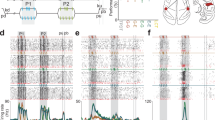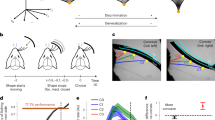Abstract
Sensory perception involves the dual challenge of encoding external stimuli and managing the influence of changes in body position that alter the sensory field. To examine mechanisms used to integrate sensory signals elicited by both external stimuli and motor activity, we recorded from rats trained to rhythmically sweep their vibrissa in search of a target. We found a select population of neurons in primary somatosensory cortex that are transiently excited by the confluence of touch by a single vibrissa and the phase of vibrissa motion in the whisk cycle; different units have different preferred phases. This conditional response enables the rodent to estimate object position in a coordinate frame that is normalized to the trajectory of the motor output, as defined by phase in the whisk cycle, rather than angle of the vibrissa relative to the face. The underlying computation is consistent with gating by an inhibitory shunt.
This is a preview of subscription content, access via your institution
Access options
Subscribe to this journal
Receive 12 print issues and online access
$209.00 per year
only $17.42 per issue
Buy this article
- Purchase on Springer Link
- Instant access to full article PDF
Prices may be subject to local taxes which are calculated during checkout







Similar content being viewed by others
References
von Holst, E. Relations between the central nervous system and the peripheral organ. Br. J. Anim. Behav. 2, 89–94 (1954).
Cullen, K.E. Sensory signals during active versus passive movement. Curr. Opin. Neurobiol. 14, 698–706 (2004).
Sommer, M.A. & Wurtz, R.H. Influence of the thalamus on spatial visual processing in frontal cortex. Nature 444, 374–377 (2006).
Roy, J.E. & Cullen, K.E. Dissociating self-generated from passively applied head motion: neural mechanisms in the vestibular nuclei. J. Neurosci. 24, 2102–2111 (2004).
Lal, R. & Friedlander, M.J. Effect of passive eye position changes on retinogeniculate transmission in the cat. J. Neurophysiol. 63, 502–522 (1990).
Ashton, J.A., Boddy, A. & Donaldson, I.M. Directional selectivity in the responses of units in cat primary visual cortex to passive eye movement. Neuroscience 13, 653–662 (1984).
Andersen, R.A., Snyder, L.H., Li, C.S. & Stricanne, B. Coordinate transformations in the representation of spatial information. Curr. Opin. Neurobiol. 3, 171–176 (1993).
Mehta, S.B., Whitmer, D., Figueroa, R., Williams, B.A. & Kleinfeld, D. Active spatial perception in the vibrissa scanning sensorimotor system. PLoS Biol. 5, e15 (2007).
Deschenes, M., Timofeeva, E., Lavallée, P. & Dufresne, E. The vibrissal system as a model of thalamic operations. Prog. Brain Res. 149, 31–40 (2005).
Fox, K. Barrel Cortex 14–48. (Cambridge University Press, Cambridge, 2008).
Kleinfeld, D., Berg, R.W. & O'Connor, S.M. Anatomical loops and their electrical dynamics in relation to whisking by rat. Somatosens. Mot. Res. 16, 69–88 (1999).
Ahissar, E. & Kleinfeld, D. Closed loop neuronal computations: focus on vibrissa somatosensation in rat. Cereb. Cortex 13, 53–61 (2003).
Berg, R.W. & Kleinfeld, D. Rhythmic whisking by rat: retraction as well as protraction of the vibrissae is under active muscular control. J. Neurophysiol. 89, 104–117 (2003).
Szwed, M., Bagdasarian, K. & Ahissar, E. Coding of vibrissal active touch. Neuron 40, 621–630 (2003).
Fee, M.S., Mitra, P.P. & Kleinfeld, D. Central versus peripheral determinates of patterned spike activity in rat vibrissa cortex during whisking. J. Neurophysiol. 78, 1144–1149 (1997).
Ganguly, K. & Kleinfeld, D. Goal-directed whisking behavior increases phase-locking between vibrissa movement and electrical activity in primary sensory cortex in rat. Proc. Natl. Acad. Sci. USA. 101, 12348–12353 (2004).
Crochet, S. & Petersen, C.C.H. Correlating membrane potential with behaviour using whole-cell recordings from barrel cortex of awake mice. Nat. Neurosci. 9, 608–609 (2006).
Yu, C., Derdikman, D., Haidarliu, S. & Ahissar, E. Parallel thalamic pathways for whisking and touch signals in the rat. PLoS Biol. 4, e124 (2006).
Pierret, T., Lavallee, P. & Deschenes, M. Parallel streams for the relay of vibrissal information through thalamic barreloids. J. Neurosci. 20, 7455–7462 (2000).
Venkatachalam, S., Fee, M.S. & Kleinfeld, D. Ultra-miniature headstage with 6-channel drive and vacuum-assisted micro-wire implantation for chronic recording from neocortex. J. Neurosci. Methods 90, 37–46 (1999).
Fee, M.S., Mitra, P.P. & Kleinfeld, D. Automatic sorting of multiple unit neuronal signals in the presence of anisotropic and non-Gaussian variability. J. Neurosci. Methods 69, 175–188 (1996).
Simons, D.J. Response properties of vibrissal units in rat S1 somatosensory neocortex. J. Neurophysiol. 41, 798–820 (1978).
Mountcastle, V.B., Talbot, W.H., Sakata, H. & Hyvarinen, J. Cortical neuronal mechanisms in flutter-vibration studied in unanesthetized monkeys, neuronal periodicity and frequency discrimination. J. Neurophysiol. 32, 452–484 (1968).
Krupa, D.J., Wiest, M.C., Shuler, M.G., Laubach, M. & Nicolelis, M.A. Layer-specific somatosensory cortical activation during active tactile discrimination. Science 304, 1989–1992 (2004).
Bartho, P. et al. Identification of neocortical principal cells and interneurons by extracellular features. J. Neurophysiol. 92, 600–608 (2004).
Derdikman, D. et al. Layer-specific touch-dependent facilitation and depression in the somatosensory cortex during active whisking. J. Neurosci. 26, 9538–9547 (2006).
Olson, C.R. Brain representation of object-centered space in monkeys and humans. Annu. Rev. Neurosci. 26, 331–354 (2003).
Leiser, S.C. & Moxon, K.A. Responses of trigeminal ganglion neurons during natural whisking behaviors in the awake rat. Neuron 53, 117–133 (2007).
Arvidsson, J. & Rice, F.L. Central projections of primary sensory neurons innervating different parts of the vibrissae follicles and intervibrissal skin on the mystacial pad of the rat. J. Comp. Neurol. 309, 1–16 (1991).
Maravall, M., Petersen, R.S., Fairhall, A.L., Arabzadeh, E. & Diamond, M.E. Shifts in coding properties and maintenance of information transmission during adaptation in barrel cortex. PLoS Biol. 5, e19 (2007).
Urbain, N. & Deschênes, M. A new thalamic pathway of vibrissal information modulated by the motor cortex. J. Neurosci. 27, 12407–12412 (2007).
Masri, R., Bezdudnaya, T., Trageser, J.C. & Keller, A. Encoding of stimulus frequency and sensor motion in the posterior medial thalamic nucleus. J. Neurophysiol. 100, 681–689 (2008).
McCormick, D.A., Connors, B.W., Lighthall, J.W. & Prince, D.A. Comparative electrophysiology of pyramidal and sparsely spiny stellate neurons of the neocortex. J. Neurophysiol. 54, 782–806 (1985).
Ahrens, K.F., Levine, H., Suhl, H. & Kleinfeld, D. Spectral mixing of rhythmic neuronal signals in sensory cortex. Proc. Natl. Acad. Sci. USA. 99, 15176–15181 (2002).
Pena, J.L. & Konishi, M. Robustness of multiplicative processes in auditory spatial tuning. J. Neurosci. 24, 8907–8910 (2004).
Andersen, R.A. & Mountcastle, V.B. The influence of angle of gaze upon the excitability of the light sensitive neurons of the posterior parietal cortex. J. Neurosci. 3, 532–548 (1983).
Salinas, E. & Abbott, L.F. A model of multiplicative neural responses in parietal cortex. Proc. Natl. Acad. Sci. USA. 93, 11956–11961 (1996).
Koch, C., Poggio, T. & Torre, V. Nonlinear interactions in a dendritic tree: localization, timing, and role in information processing. Proc. Natl. Acad. Sci. USA. 80, 2799–2802 (1983).
Richardson, M.J., Brunel, N. & Hakim, V. From subthreshold to firing-rate resonance. J. Neurophysiol. 89, 2538–2554 (2003).
Rudolph, M., Pospischil, M., Timofeev, I. & Destexhe, A. Inhibition determines membrane potential dynamics and controls action potential generation in awake and sleeping cat cortex. J. Neurosci. 16, 5280–5290 (2007).
Lee, A.K., Manns, I.D., Sakmann, B. & Brecht, M. Whole-cell recordings in freely moving rats. Neuron 51, 399–407 (2006).
de Kock, C.P., Bruno, R.M., Spors, H. & Sakmann, B. Layer- and cell-type-specific suprathreshold stimulus representation in rat primary somatosensory cortex. J. Physiol. (Lond.) 581, 139–154 (2007).
Manns, I.D., Sakmann, B. & Brecht, M. Sub- and suprathreshold receptive field properties of pyramidal neurones in layers 5A and 5B of rat somatosensory barrel cortex. J. Physiol. (Lond.) 556, 601–622 (2004).
Knutsen, P.M., Pietr, M. & Ahissar, E. Haptic object localization in the vibrissal system: behavior and performance. J. Neurosci. 26, 8451–8464 (2006).
Bruno, R.M., Khatri, V., Land, P.W. & Simons, D.J. Thalamocortical angular tuning domains within individual barrels of rat somatosensory cortex. J. Neurosci. 19, 7603–7616 (2003).
Andermann, M.L. & Moore, C.I. A somatotopic map of vibrissa motion direction within a barrel column. Nat. Neurosci. 9, 543–551 (2006).
Kleinfeld, D., Sachdev, R.N.S., Merchant, L.M., Jarvis, M.R. & Ebner, F.F. Adaptive filtering of vibrissa input in motor cortex of rat. Neuron 34, 1021–1034 (2002).
Armstrong-James, M., Fox, K. & Das-Gupta, A. Flow of excitability within barrel cortex on striking a single vibrissa. J. Neurophysiol. 68, 1345–1358 (1992).
Brown, E.N., Frank, L.M., Tang, D., Quirk, M.C. & Wilson, M.A. A statistical paradigm for neural spike train decoding applied to position prediction from ensemble firing patterns of rat hippocampal place cells. J. Neurosci. 18, 7411–7425 (1998).
DiMatteo, I., Genovese, C.R. & Kass, R.E. Bayesian curve-fitting with free-knot splines. Biometrika 88, 1055–1071 (2001).
Acknowledgements
We thank S.B. Mehta for assistance with spike sorting, E.N. Brown and R.E. Kass for instruction on spike-train analysis, G.A. White for electronics support, E. Ahissar, W. Denk, M. Deschenes, M.E. Diamond, A.L. Fairhall, D.N. Hill and T.J. Sejnowski for relevant discussions, D. Matthews for reading of the manuscript, and the US National Institutes of Health (NS051177), the US National Science Foundation (IGERT) and the US/Israel Binational Foundation (2003222) for financial support.
Author information
Authors and Affiliations
Corresponding author
Supplementary information
Supplementary Text and Figures
Supplementary Figures 1–12 (PDF 5657 kb)
Rights and permissions
About this article
Cite this article
Curtis, J., Kleinfeld, D. Phase-to-rate transformations encode touch in cortical neurons of a scanning sensorimotor system. Nat Neurosci 12, 492–501 (2009). https://doi.org/10.1038/nn.2283
Received:
Accepted:
Published:
Issue Date:
DOI: https://doi.org/10.1038/nn.2283
This article is cited by
-
High-frequency burst spiking in layer 5 thick-tufted pyramids of rat primary somatosensory cortex encodes exploratory touch
Communications Biology (2021)
-
Reduction of corpus callosum activity during whisking leads to interhemispheric decorrelation
Nature Communications (2021)
-
Flexible simultaneous mesoscale two-photon imaging of neural activity at high speeds
Nature Communications (2021)
-
Recurrent interactions in local cortical circuits
Nature (2020)
-
Sensorimotor processing in the rodent barrel cortex
Nature Reviews Neuroscience (2019)



